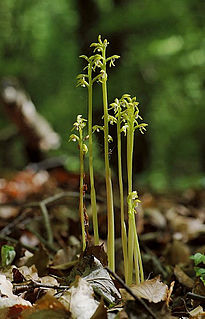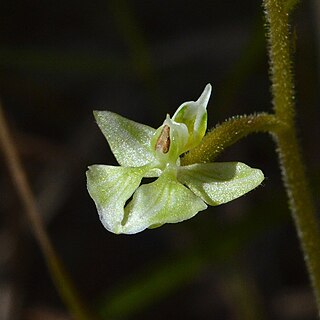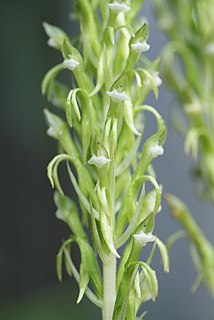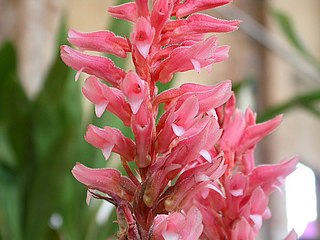
Vanilla, the vanilla orchids, forms a flowering plant genus of about 110 species in the orchid family (Orchidaceae). The most widely known member is the flat-leaved vanilla, native to Mexico, from which commercial vanilla flavoring is derived. It is the only orchid widely used for industrial purposes in flavoring such products as foods, beverages and cosmetics, and is recognized as the most popular aroma and flavor. The key constituent imparting its popular characteristics is the phenolic aldehyde, vanillin.

Dendrophylax lindenii, the ghost orchid is a perennial epiphyte from the orchid family (Orchidaceae). It is native to Florida and Cuba. Other common names include palm polly and white frog orchid.

Corallorhiza trifida, commonly known as early coralroot, northern coralroot, or yellow coralroot, is a coralroot orchid native to North America and Eurasia, with a circumboreal distribution. The species has been reported from the United States, Canada, Russia, China, Japan, Korea, India, Nepal, Kashmir, Greenland, Pakistan, and almost every country in Europe.
Banksia porrecta is a species of prostrate shrub that is endemic to the south-west of Western Australia. It has hairy, underground stems, pinnatipartite leaves with up to forty narrow triangular lobes on each side, yellow flowers in heads of between twenty and thirty, and one or two egg-shaped follicles in each head.

Didymoplexis, commonly known as crystal orchids or as 双唇兰属 , is a genus of terrestrial leafless orchids in the family Orchidaceae, about twenty species of which have been described. Orchids in this genus have swollen, fleshy rhizomes and thin, pale, upright fleshy flowering stems with resupinate, bell-shaped white or pale yellowish brown flowers. They are native to Africa, Madagascar, Southeast Asia, Australia and various islands of the Pacific.

Dipodium, commonly known as hyacinth orchids, is a genus of about forty species of orchids native to tropical, subtropical and temperate regions of south-east Asia, New Guinea, the Pacific Islands and Australia. It includes both terrestrial and climbing species, some with leaves and some leafless, but all with large, often colourful flowers on tall flowering stems. It is the only genus of its alliance, Dipodium.

Dendrophylax is a genus of leafless neotropical orchids native to Mexico, Central America, the West Indies, and Florida. The name is from Greek δένδρον ("tree") and φύλαξ. One species, Dendrophylax lindenii, featured heavily in the book The Orchid Thief.

Ponthieva racemosa, commonly called the hairy shadow witch or racemose ponthieva, is a species of orchid found from the southeastern United States, Mexico, Central America, the West Indies and northern South America as far south as Bolivia.

Triphora is a genus of flowering plants from the orchid family, Orchidaceae. It is native to South America, Central America, southern Mexico, the West Indies and eastern North America as far north as Ontario. Noddingcaps is a common name for plants in this genus.
- Triphora amazonicaSchltr. - Florida, Caribbean, south to Brazil
- Triphora carnosula(Rchb.f.) Schltr. - Brazil
- Triphora craigheadiiLuer - Florida
- Triphora debilis(Schltr.) Schltr. - southern Mexico, Costa Rica, Guatemala, Panama
- Triphora duckeiSchltr. - Brazil
- Triphora foldatsiiCarnevali - Venezuela
- Triphora gentianoides(Sw.) Nutt. ex Ames & Schltr. - Florida, Southern Mexico, Costa Rica, Veenzuela, Colombia, Ecuador, Bahamas, Greater Antilles
- Triphora hassleriana(Cogn. ex Chodat & Hassl.) Schltr. - from Mexico to Argentina
- Triphora heringeriPabst - Brazil
- Triphora miserrima(Cogn.) Acuña - Cuba, Hispaniola
- Triphora nitida(Schltr.) Schltr. - Costa Rica
- Triphora pusilla(Rchb.f. & Warm.) Schltr. - Brazil
- Triphora ravenii(L.O.Williams) Garay - Costa Rica, Panama
- Triphora santamariensisPortalet - Brazil
- Triphora surinamensis(Lindl. ex Benth.) Britton - West Indies south to Brazil
- Triphora trianthophoros(Sw.) Rydb. Ontario, Eastern United States, much of Mexico
- Triphora unifloraA.W.C.Ferreira, Baptista & Pansarin - Brazil
- Triphora wagneriSchltr. - from Mexico to Ecuador
- Triphora yucatanensisAmes - Florida and the Yucatán Peninsula

Pelexia is a genus of flowering plants from the orchid family, Orchidaceae. It has about 60-70 accepted species, native to Latin America, the West Indies and Florida.

Sacoila is a genus of flowering plants from the orchid family, Orchidaceae, native to the Western Hemisphere. It occurs in Mexico, Central America, South America, the West Indies and Florida.

Angraecinae is a subtribe in the family Orchidaceae. The subtribe consists of approximately 18 genera and about 360 species. The type genus is Angraecum. Most of the genera are endemic to Africa, Madagascar and other Indian Ocean Islands, a few genera can also be found in the Americas.
Dipodium campanulatum, commonly known as the bell-flower hyacinth orchid, is a leafless mycoheterotroph orchid that is endemic to south-eastern Australia. In summer it has up to thirty five white flowers with large, dark red spots and blotches.
Dipodium pulchellum is an almost leafless orchid that is endemic to north-east New South Wales and south-east Queensland in Australia. Up to forty pink flowers with darker blotches are borne in summer and winter on flowering spikes up to 90 cm (40 in) long.

Bletia purpurea, common name pine-pink or sharp-petaled bletia, is a species of orchid widespread across much of Latin America and the West Indies, and also found in Florida. They are terrestrial in swamps or sometimes found growing on logs or stumps above the high tide mark.
Tropidia polystachya, the young palm orchid, is a species of orchid native to Mexico, Central America, Greater Antilles, Bahamas, Cayman Islands, Florida, Colombia, Venezuela, and Ecuador.

Cranichis muscosa, the cypress-knee helmet orchid, is a species of terrestrial orchid. It is widespread across most of the West Indies, extending into Central America, southern Mexico, northern South America, and southern Florida.
Habenaria macroceratitis, the big-horn bog orchid or long-horned false rein orchid, is a species of orchid closely related to H. quinqueseta and often mistaken for it. Habenaria macroceratitis is native to Central America, Mexico, the West Indies, northern South America, and Florida.

Liparis liliifolia, known as the brown widelip orchid, lily-leaved twayblade, large twayblade, and mauve sleekwort, is a species of orchid native to eastern Canada and the eastern United States. It can be found in a variety of habitats, such as forests, shrublands, thickets, woodlands, and mountains. The orchid is considered globally secure, but it is considered rare or endangered in many northeastern states.

Praecoxanthus aphyllus, commonly known as leafless orchid, is the only species of the flowering plant genus Praecoxanthus in the orchid family, Orchidaceae and is endemic to the south-west of Western Australia. Plants in flower lack a true leaf, although those plants that are not flowering do possess a green leaf. This species is one of the first orchids to flower each year and its creamy white, fragrant flower easily distinguishes it from other species.














